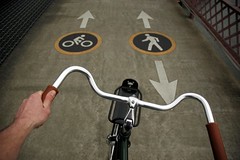A recent crash between two people riding over the Hawthorne Bridge has raised concerns about the safety of the facility for non-motorized users — and it’s far from the first time these concerns have come up.
In December of 2006, we published an editorial by Elly Blue titled “Re-thinking traffic on the Hawthorne Bridge,” where she wrote, “…traffic congestion on the Hawthorne Bridge is a serious problem.”
Last summer, Vancouver BC resident Ron Richings visited Portland. Richings is an avid rider who contributes to Momentum Magazine, volunteers in the bike scene, and makes an annual visit to Portland to take part in Pedalpalooza and other events.
On July 13th, 2008 he posted a message to the Shift email list about concerns he had about riding over the Hawthorne Bridge:
“While riding around I noticed again a considerable hazard on the Hawthorne bridge — the lack of any physical separation between the sidewalk/bike path and the traffic lanes. Likewise, and depending on the lighting conditions, the difficulty in seeing where the sidewalk ends and the bridge deck (several inches lower) begins… This is [an] unaddressed hazard is surprising to me given the large number of cyclists who use this bridge on a daily basis.”
“Also troubling is that it could just as easily be me as any other cyclist who ends up crashing onto the bridge deck in the middle of traffic. Not a pretty picture.”
— Ron Richings, in a letter to Multnomah County Commissioners last summer
Two days later, he wrote a letter to the Multnomah County Commissioners (Multnomah County owns and operates the bridge) detailing those concerns and asking if they had any plans to do something about the situation.
Here’s an excerpt from that letter (emphasis mine):
“These unaddressed hazards were surprising to me given the large number of local cyclists who use this bridge on a daily basis, and Portland’s reputation for being ‘bike friendly’. Also troubling is that it could just as easily be me as any other cyclist who ends up crashing onto the bridge deck in the middle of traffic. Not a pretty picture.
Ideally the County should install a proper physical barrier. However if that isn’t immediately possible, then at least the County should promptly mark the edge of the sidewalk, preferably with a continuous yellow stripe. It seems like this should be a quick, easy and inexpensive project which could help to prevent some serious injury.”
Multnomah County Transportation Planner Jane McFarland responded to Richings’ email and said they would look into the issue. I called her this morning to ask what, if anything, had happened since July.
McFarland said they evaluated both of Richings’ suggestions, particularly the one about putting up a railing.
According to McFarland, the sidewalk is as wide as it can be without strengthening the bridge structure and that it is “currently considered narrow given the amount of pedestrian and bicycle usage.”
McFarland said a barrier is not currently being considered because the sidewalk is already too narrow. It would require a foot of sidewalk width and it would take away from the “functional width” due to the tendency of users to want separation from a barrier (known as “shy distance”). “We felt it would diminish the usable space,” McFarland said.
In addition, McFarland said that depending on the height, “You could be inducing a more severe accident if someone where to go over the railing.”
The next idea they considered was to stripe the edge of the sidewalk to visually delineate the curb. The County would use thermoplastic striping and McFarland said the project is on the County’s Capital Improvement Project list that is set to be updated and confirmed in the next few months. County staff estimates the cost to be between $12,000 and $15,000 (much of the cost comes from the logistical/operational issues of closing lanes and operating crews on the bridge deck).
In addition to the striping, McFarland says the new bike/ped facility in the works on the nearby Morrison Bridge will help: “We anticipate this improvement will substantially relieve conditions on the Hawthorne Bridge shared sidewalk.”
UPDATE:
— I just spoke to Multnomah County spokesman Michael Pullen about the possibility of putting a railing/barrier more into the roadway on the main deck of the bridge (as opposed to taking space on the already too narrow bike/ped path). He said that won’t happen. TriMet runs about 1,000 buses across the bridge each day and they can’t fit in the center lanes so they must use the outer lanes and a railing would encroach on their path.
As for having bicycles ride on the main roadway, Pullen said that idea is pretty close to a non-starter. The cost for a material to lay over the metal grate would be prohibitively expensive, and there would be safety concerns about mixing cars, buses, and bikes on the narrow lane. Pullen and I couldn’t agree whether or not it would be technically illegal to take the lane on the Hawthorne (you could try to convince a judge that the path is too dangerous), but we did agree that it would probably be a lot more fun on a mountain bike.


